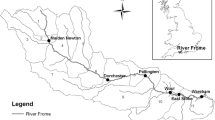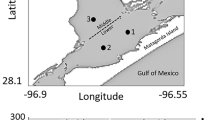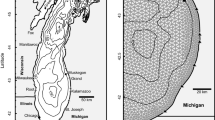Abstract
The results of a modelling study to investigate the mechanisms controlling macroalgal growth within the Medway estuary, UK, are presented. Intertidal zone bathymetry, tidal dynamics and turbidity control the time available for nutrient uptake and photosynthesis, and were used as a basis for predicting areas where macroalgae will grow. Tidal bed stress was also considered as a controlling factor for the presence of the less robust green macroalgae species. Two approaches to predicting macroalgal distributions were applied: (1) a simple ‘suitability index’ method based on tidal flooding and drying, taking account of the conflict between time available for nutrient uptake and for photosynthesis; and (2) a biological macroalgal growth model that includes a detailed treatment of nutrient uptake and plant growth. The former approach assigns a value between zero and one for the suitability of a location for macroalgal occurrence, while the latter predicts the full macroalgal growth dynamics over an annual cycle. Tidal bed stress was included in both approaches as an independent modifier of macroalgal occurrence/growth. Results were compared with aerial survey maps of observed vegetation cover and time series of measured biomass density. Both approaches gave good predictions of non-species-specific vegetation cover in the intertidal zone of the Medway. Tidal bed stress was found to be a strong predictor of the specific occurrence of Enteromorpha spp. and Ulva spp., with these species favouring areas of low tidal energy. It was concluded that light and a lack of suitable regions with low tidal bed stress, rather than nutrients, were the main factors limiting excessive growth of Enteromorpha spp. and Ulva spp. in the estuary. Although this study was focussed on the Medway, the results are likely to be applicable to a broad range of relatively turbid, meso- and macro-tidal estuaries.










Similar content being viewed by others
References
Aisha, K. A. & E. F. Shabana, 1995. Pulse feeding with nitrate and phosphate in relation to tissue composition and nutrient uptake by some macroalgae from the Red Sea at the Ghardaqa (Egypt). Journal of Basic Microbiology 35: 135–145.
Alvera-Azcarate, A., J. G. Ferreira & J. P. Nunes, 2003. Modelling eutrophication in mesotidal and macrotidal: the role of intertidal seaweeds. Estuarine, Coastal and Shelf Science 57: 715–724.
Atkinson, M. & S. V. Smith, 1983. C:N:P Ratios of benthic marine plants. Limnology and Oceanography 28: 568–574.
Babey, S. K. & R. J. Soffer, 1992. Radiometric calibration of the Compact Airborne Spectrographic Imager (CASI). Canadian Journal of Remote Sensing 18: 233–242.
Ballentine, W. J., 1961. A biologically defined exposure scale for comparative description of rocky shores. Field Study 1: 1.
Bjornsater, B. R. & P. A. Wheeler, 1990. Effect of nitrogen and phosphorus supply on growth and tissue composition of Ulva fenestrata and Enteromoprha intestinalis (Ulvales, Chlorophyta). Journal of Phycology 26: 603–611.
Brown, K., 2004. Medway CASI Survey, Project PM_0282. UK Environment Agency, Lower Bristol Road, Bath, BA2 9ES, UK.
Cefas, 2003. Investigation of factors controlling the presence of macroalgae in some estuaries of the Southern Water Region. Centre for Environment, Fisheries & Aquaculture Science. Contract C1642.
den Hartog, C., 1994. Suffocation of a littoral Zostera bed by Enteromorpha radiata. Aquatic Botany 47: 21–28.
Dring, M. J., 1986. The Biology of Marine Plants. Contemporary Biology. Edward Arnold, London.
Eilola, K. & V. Stigebrandt, 2001. Modelling filamentous algae mats in shallow bays. EU Life Algae Project, Rapport 2001:38, Länsstyrelsen i Västra Götaland, Göteborg.
Gurney, W. S. C. & R. M. Nisbet, 1998. Ecological Dynamics. Oxford University Press, New York.
HR Wallingford, 2004. Water quality model development for the Medway and Swale. Report EX4662, Dec 2004.
Jones, J. E., 2005. An intercomparison between finite difference and finite element (TELEMAC) approaches to modelling west coast of Britain tides. Ocean Dynamics 55: 178–198.
Lapointe, B. E. & K. R. Tenore, 1981. Experimental outdoor studies with Ulva fasciata Delile. I. Interaction of light and nitrogen on nutrient uptake, growth, and biochemical composition. Journal of Experimental Marine Biology and Ecology 53: 135–152.
Lavery, P. S., R. J. Lukatelich & A. J. McCoomb, 1991. Changes in the biomass and species composition of macroalgae in a eutrophic estuary. Estuarine, Coastal and Shelf Science 33: 1–22.
Lowthion, D., P. G. Soulsby & M. C. M. Houston, 1985. Investigation of a eutrophic tidal basin: 1. Factors affecting the distribution and biomass of macroalgae. Marine Environmental Research 15: 263–284.
Martins, I. & J. C. Marques, 2002. A model for the growth of opportunistic macroalgae (Enteromorpha spp.) in tidal estuaries. Estuarine, Coastal and Shelf Science 55: 247–257.
Martins, I. & M. Pardal, 2001. Hydrodynamics as a major factor controlling the occurrence of green macro-algal blooms in a eutrophic estuary: a case study on the influence of precipitation and river management. Estuarine, Coastal and Shelf Science 52: 165–177.
Mohsen, A. F., A. F. Khaeafa & A. Metwalli, 1974. Effect of different nitrogen sources on growth, reproduction, amino acid, fat and sugar contents in Ulva fasaata Delile. Botanica Marina 17: 218–222.
Nedwell, D. B., L. F. Dong, A. Sage & G. J. C. Underwood, 2002. Variations of the nutrients loads to the mainland U.K. estuaries: correlation with catchment areas, urbanization and coastal eutrophication. Estuarine, Coastal and Shelf Science 54: 951–970.
Pedersen, M. F. & J. Borum, 1997. Nutrient control of estuarine macroalgae: growth strategy and the balance between nitrogen requirements and uptake. Marine Ecology Progress Series 161: 155–163.
Pratt, A., 2001. Review of sensitive water status, Medway estuary, Kent. Environment Agency (Southern Region) Report, ref 10173.
Pye, K., 2000. The effects of eutrophication on the marine benthic flora of Langstone Harbour, south coast of England. PhD thesis, University of Portsmouth.
Rosenberg, G. & J. Ramus, 1982. Ecological growth strategies in the seaweeds Gracilaria foliifera (Rhodophyceae) and Ulva spp. (Chlorophyceae): soluble nitrogen and reserve carbohydrates. Marine Biology 66: 251–259.
Sanders, R., C. Klein & T. Jickells, 1997. Biogeochemical nutrient cycling in the upper Great Ouse estuary, Norfolk, U.K. Estuarine, Coastal and Shelf Science 44: 543–555.
Sfriso, A., 1995. Temporal and spatial responses of growth of Ulva rigida C. Ag. to environmental and tissue concentrations of nutrients in the Lagoon of Venice. Botanica Marina 38: 557–573.
Sfriso, A., B. Pavoni & A. Marcomini, 1989. Macroalgae and phytoplankton standing crops in the central Venice Lagoon: primary production and nutrient balance. Science of the Total Environment 80: 139–159.
Solidoro, C., G. Pecenik, R. Pastres, D. Franco & C. Dejak, 1997. Modelling macroalgae (Ulva rigida) in the Venice Lagoon: model structure identification and first parameter estimation. Ecological Modelling 94: 191–206.
Trancoso, A. R., S. Saraiva, L. Fernandes, P. Pina, P. Leitao & R. Neves, 2005. Modelling macroalgae using a 3D hydrodynamic-ecological model in a shallow, temperate estuary. Ecological Modelling 187: 232–246.
Trimmer, M., D. B. Nedwell, D. B. Sivyer & S. J. Malcolm, 2000. Seasonal organic mineralisation and denitrification in intertidal sediments and their relationship to abundance of Enteromorpha sp. and Ulva sp. Marine Ecology Progress Series 203: 67–80.
Tubbs, C. R. & J. M. Tubbs, 1983. Macroalgal mats in Langstone Harbour, Hampshire, England. Marine Pollution Bulletin 14: 148–149.
Acknowledgements
The authors would like to acknowledge the support of the UK Environment Agency (southern region) in funding this work and supplying data. In particular, Dave Lothian who commissioned the work and Alastair Pratt who supplied much useful advice and data. We also acknowledge the work of Elfed Jones at HR Wallingford in setting up and running the hydrodynamic and nutrient transport models of the Thames and Medway estuaries. Support under Cefas contracts DP193 and Defra under contract E2202 is acknowledged for enabling this work to be presented and prepared for publication. We also acknowledge the detailed and useful comments from two anonymous referees that helped to significantly improve the original manuscript.
Author information
Authors and Affiliations
Corresponding author
Additional information
Guest editors: J. H. Andersen & D. J. Conley
Eutrophication in Coastal Ecosystems: Selected papers from the Second International Symposium on Research and Management of Eutrophication in Coastal Ecosystems, 20–23 June 2006, Nyborg, Denmark
Electronic supplementary material
Below is the link to the electronic supplementary material.
Rights and permissions
About this article
Cite this article
Aldridge, J.N., Trimmer, M. Modelling the distribution and growth of ‘problem’ green seaweed in the Medway estuary, UK. Hydrobiologia 629, 107–122 (2009). https://doi.org/10.1007/s10750-009-9760-6
Published:
Issue Date:
DOI: https://doi.org/10.1007/s10750-009-9760-6




